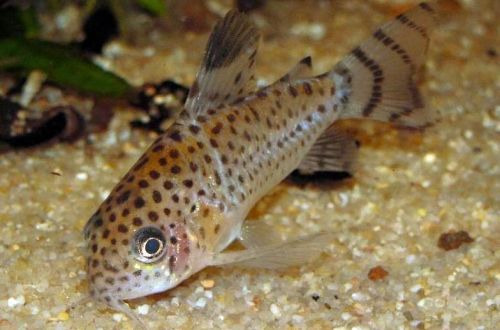
Loricaria Peruvian
Peruvian Loricaria, scientific name Rineloricaria lanceolata, belongs to the family Loricariidae (Mail catfish). It is considered one of the most popular catfish due to its modest size, ease of maintenance and peaceful disposition.

Contents
Habitat
The fish comes from South America from the upper Amazon basin from the territory of Peru and the western states of Brazil. Inhabits shallow streams and rivers, prefers regions with sandy substrates littered with fallen leaves, branches and other plant organic matter.
Brief information:
- The volume of the aquarium is from 60–80 liters.
- Temperature – 25-28°C
- Value pH — 6.0–8.0
- Water hardness – soft to medium hard (2-15 dGH)
- Substrate type – sandy
- Lighting – subdued
- Brackish water – no
- Water movement – light or moderate
- The size of the fish is 9–11 cm.
- Nutrition – any sinking food with herbal supplements
- Temperament – peaceful
- Single or group content
Description
Adult individuals reach a length of 9–11 cm. The catfish has an elongated body with a thin caudal stalk, which is crowned with a small pointed tail. Because of the similar body shape in English-speaking countries, this species is called Whiptail Catfish (Catfish whip or whip).
Coloration and body pattern depend on the specific regional form. The colors may be dominated by brown, gray and even red-brick tones. The latter are probably the result of hybridization and such catfish are known as red Loricaria.
Sexual dimorphism is weakly expressed. Males can be distinguished from females by the presence on the head and on the first rays of the pectoral fins of special small bristles called odontots.
Food
Will accept most popular sinking foods dry, frozen and live. For example, flakes, granules in combination with bloodworms, brine shrimp, tubifex, etc. can become the basis of a daily diet.
Feed must contain herbal supplements, or be served separately. Blanched lettuce, spinach, vegetable pieces (cucumber, zucchini, etc.) are good choices.
Maintenance and care, arrangement of the aquarium
The optimal size of the aquarium for a group of 2-3 fish starts from 60-80 liters. In the design, it is recommended to use sandy, gravel soil or any other substrate consisting of small particles. Natural or artificial driftwood and other decorative elements will serve as a place to hide.
When choosing aquatic plants, you should give preference to species with a strong root system or plant them in separate pots, which are then immersed in the ground. Otherwise, there is a high probability that catfish will damage the plants.
Due to the ability to adapt to a wide range of temperatures and values of hydrochemical parameters, the process of water treatment is reduced to the usual settling of water. If there are no other fish in the aquarium, there is no need to change the pH and dGH values.
Aquarium maintenance is standard and consists of several basic procedures: weekly replacement of part of the water with fresh water, removal of organic waste (food leftovers, excrement), cleaning of the tank walls and design elements, equipment maintenance.
Behavior and Compatibility
Peacefully tuned in relation to relatives and other species of comparable size. Hard body covers provide reliable protection, therefore, in some cases, the Peruvian Loricaria will be able to stand up for itself in the company of quarrelsome, but at the same time small fish.
Breeding / breeding
Breeding is quite simple. The only difficulty is getting a pair. Catfish are picky in terms of choosing a partner, so it is necessary to acquire a male and female who have already given offspring, or a group of at least 6 individuals of different sexes to guarantee the appearance of at least one pair.
The stimulus for spawning is a gradual decrease in water temperature by 3–4 degrees within one or two days and the subsequent maintenance of the achieved values. Herbal supplements must be present in the diet.
When the fish are ready to spawn, the male proceeds to choose a place for future masonry. Usually they become some secluded place (cave, grotto). Breeders often use ordinary PVC tubes with a diameter of about 5 cm. Having carefully cleaned the place, the male invites the castle. After a short courtship, the female lays several dozen eggs. The male stays near the clutch to protect it.
The incubation period lasts 4–5 days, after another 2–3, the fry begin to swim freely. From this moment on, parental instincts weaken and adult catfish can eat their own offspring. Juveniles are recommended to be transplanted into a separate tank.
Fish diseases
In aquariums with a healthy ecosystem, proper nutrition, and the absence of threats in the form of aggressive fish, cases of disease are very rare. Symptoms of the disease will usually indicate management problems (injuries, poor water quality, poor feed, etc.). If the root causes are eliminated, then the body of the catfish can independently cope with the disease. Otherwise, medical treatment will be required, more details in the section “Diseases of aquarium fish”.





